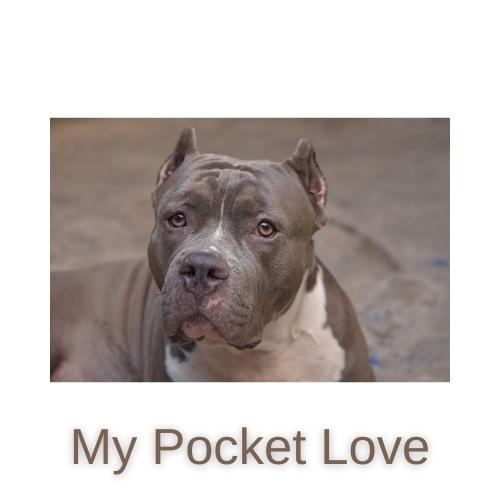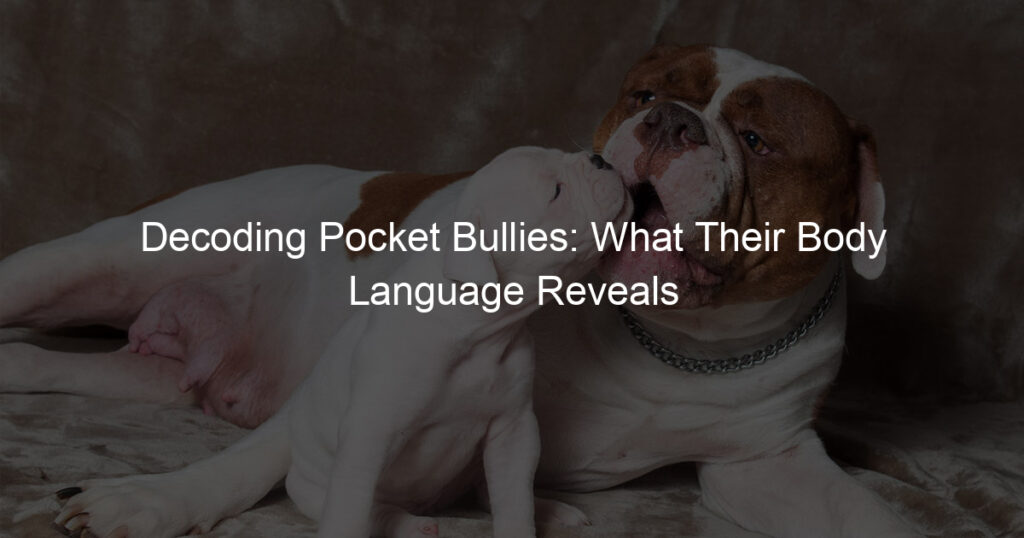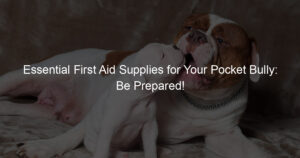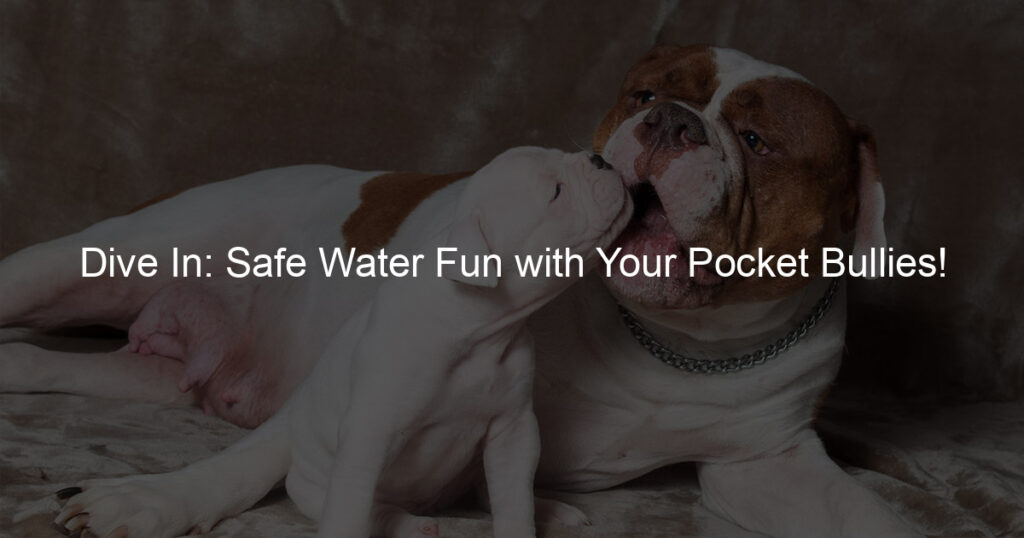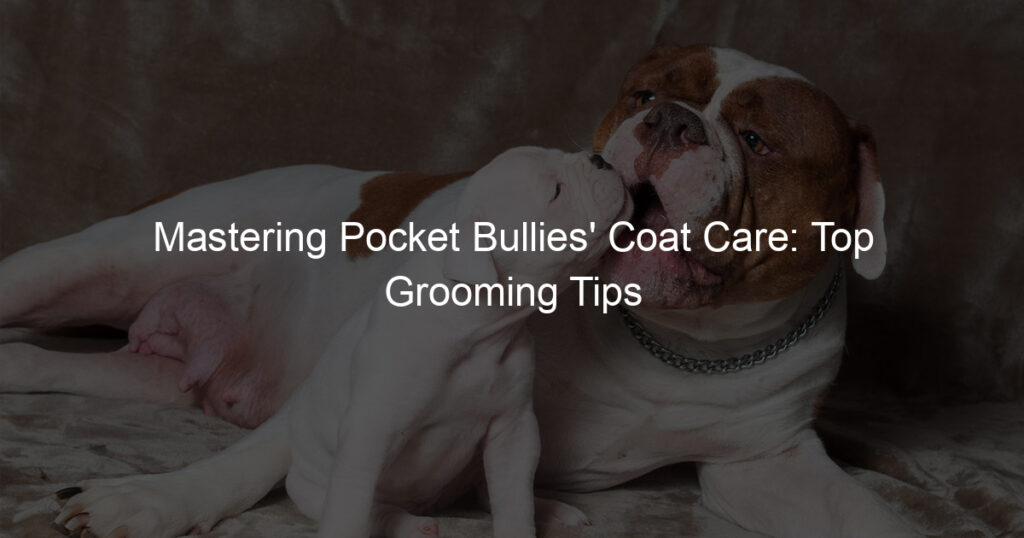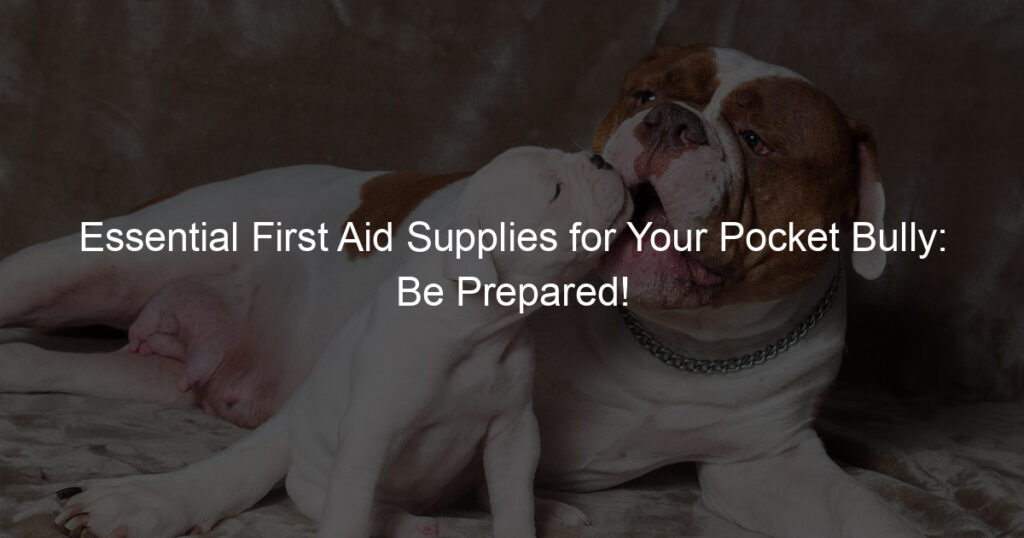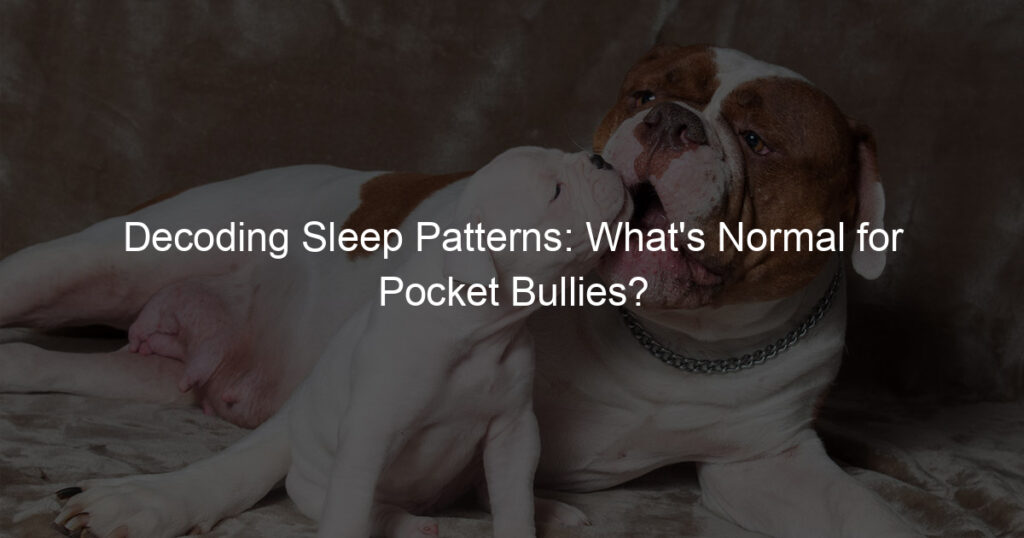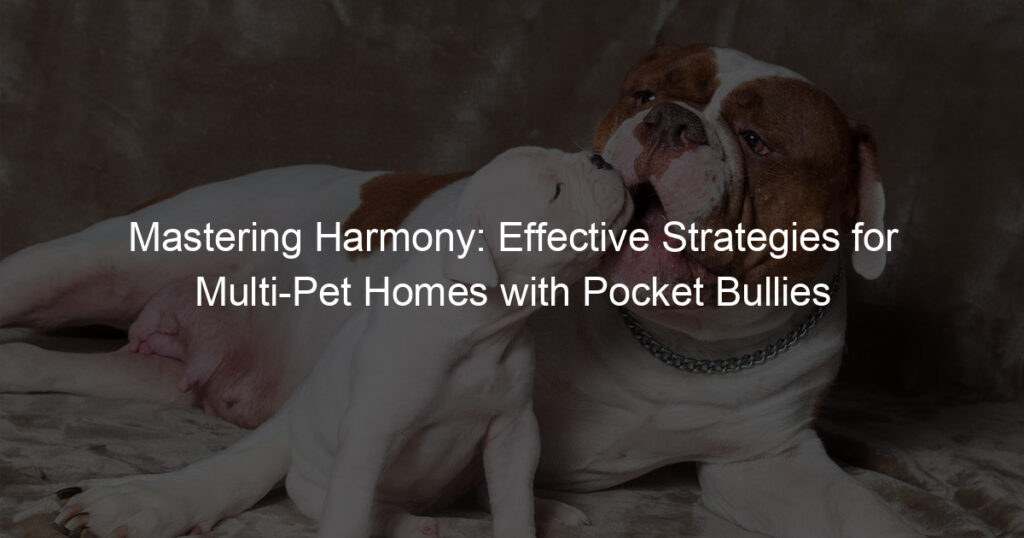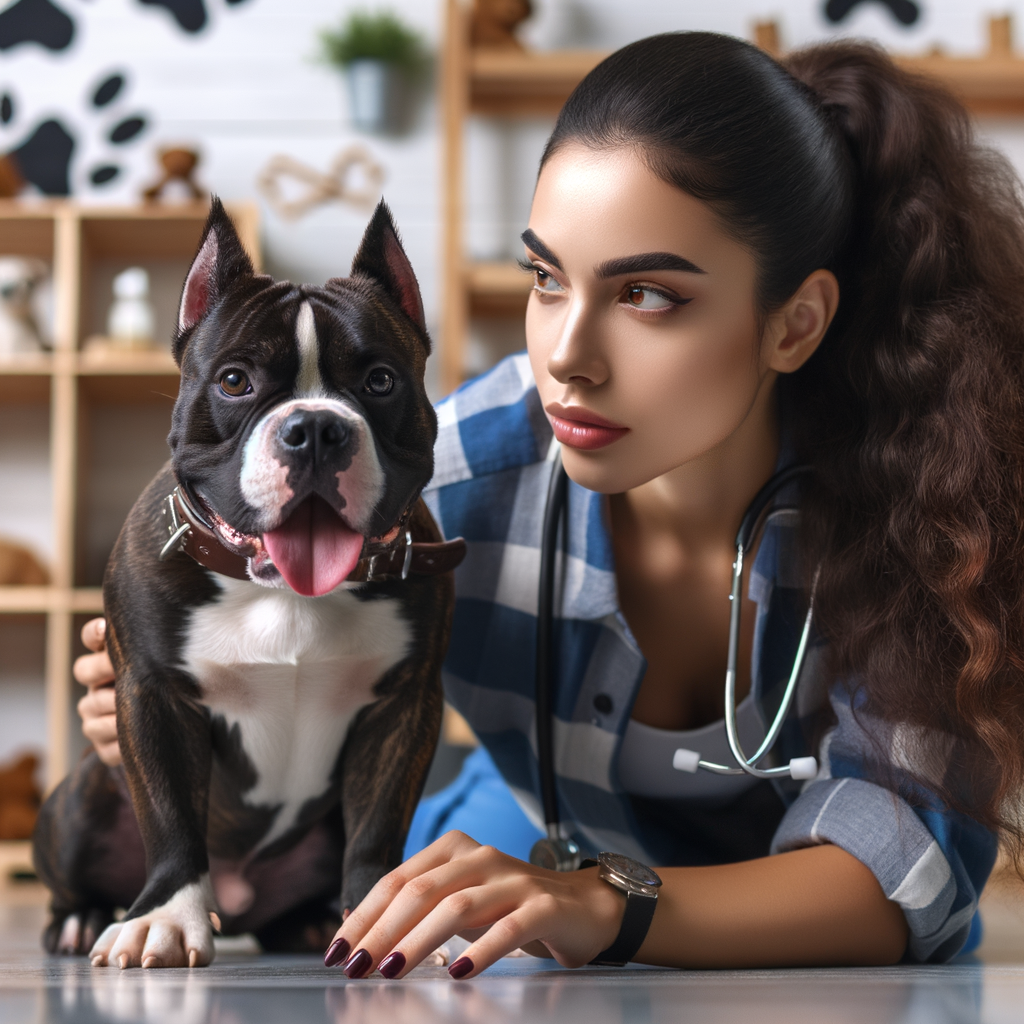
Introduction to Pocket Bullies’ Body Language
When it comes to understanding your Pocket Bully, one of the most important aspects to focus on is their body language. Dogs, like humans, communicate a lot through their body language. By understanding this language, you can build a stronger bond with your pet and ensure their well-being.
- Understanding the importance of body language in dogs
Body language in dogs is a vital form of communication. Dogs use their body language to express their feelings, intentions, and reactions. They use different parts of their bodies, such as their ears, tail, and posture, to communicate. Understanding your dog’s body language can help you identify their needs, fears, and even health issues early on. It also allows you to respond appropriately to their behavior, ensuring a healthy and happy relationship with your pet.
- Specific traits of Pocket Bullies
Pocket Bullies, a breed of American Bully, have their unique body language traits. They are known for their muscular body, short stature, and friendly temperament. When a Pocket Bully is relaxed and happy, their body is loose, and their tail wags in a relaxed manner. They may also show their belly, which is a sign of trust and comfort.
On the other hand, if a Pocket Bully is scared or anxious, they may tuck their tail between their legs, lower their body, and avoid eye contact. They may also show signs of aggression when they feel threatened, such as stiffening their body, showing their teeth, and growling. It’s crucial to understand these specific traits to ensure you can provide the best care for your Pocket Bully.
Understanding your Pocket Bully’s body language is not just about knowing when they are happy or scared. It’s about understanding their overall well-being and ensuring they feel safe, loved, and cared for. Remember, a well-understood dog is a happy dog!
Understanding Pocket Bullies: A Comprehensive Guide
In this section, we will delve into the physical characteristics of Pocket Bullies. Understanding these traits is crucial to better comprehend their behavior and needs.
Physical Characteristics of Pocket Bullies
Pocket Bullies are unique dogs with distinct physical features. Let’s explore some of these characteristics:
- Size and Stature
- Color and Coat
- Facial Expressions
Pocket Bullies are compact and muscular dogs. Despite their name, they are not miniature dogs. They typically stand between 12 to 16 inches tall at the shoulder and weigh between 30 to 60 pounds. Their size and stature give them a powerful appearance, but they are known for their friendly and gentle nature.
The coat of a Pocket Bully is short, shiny, and stiff to the touch. They come in a variety of colors including black, blue, brown, and white. Some may even have a combination of these colors. Their coat is easy to groom and they are not heavy shedders.
One of the most endearing features of Pocket Bullies is their expressive faces. They have a broad, wrinkled face with a short muzzle and large, round eyes. Their eyes are full of expression and they use them effectively to communicate their emotions. A happy Pocket Bully will have bright, alert eyes while a sad or anxious one may have droopy eyes.
Understanding these physical characteristics can help owners and potential adopters to better understand and care for their Pocket Bullies. Remember, every Pocket Bully is unique and may not fit perfectly into these descriptions. It’s always best to spend time with your Pocket Bully to understand their individual characteristics and personality.
Behavioral Traits of Pocket Bullies
Understanding the behavior of Pocket Bullies is crucial for a harmonious relationship. Let’s delve into their general behavior, their interaction with humans, and their interaction with other dogs.
- General behavior
Pocket Bullies are known for their energetic and playful nature. They are intelligent dogs that are eager to learn and please their owners. Despite their tough exterior, they are generally affectionate and gentle dogs. They thrive on human interaction and are not typically aggressive unless they feel their family is threatened.
- Interaction with humans
Pocket Bullies are excellent companions. They are very loyal and protective of their human family. They are known to be great with children, showing patience and gentleness. Training them from a young age to interact positively with humans is essential. They are eager to please their owners and respond well to positive reinforcement techniques.
- Interaction with other dogs
When it comes to interacting with other dogs, Pocket Bullies can be a bit of a mixed bag. Some get along well with other dogs, while others may show signs of aggression or dominance. Early socialization is key to ensuring they can interact safely and positively with other dogs. It’s also important to remember that each Pocket Bully is an individual and their behavior can vary.
Decoding Pocket Bullies’ Needs through Their Body Language
Understanding your Pocket Bullies’ body language is crucial in meeting their needs. Let’s delve into some common signs that your Pocket Bully may exhibit when they are hungry or thirsty, need to go outside, or want to play.
- Signs of hunger or thirst
- Signs of needing to go outside
- Signs of wanting to play
When your Pocket Bully is hungry, they may start to follow you around more than usual, or they might go to the area where their food is usually served and wait. They might also lick their lips or chew on non-food items. If they’re thirsty, they might lick their lips more frequently, or you might notice them panting more than usual.
If your Pocket Bully needs to go outside, they might start to pace around, whine, or scratch at the door. They might also start to circle or sniff around more than usual. These are clear signs that your Pocket Bully needs to relieve themselves and should be taken outside immediately.
When your Pocket Bully wants to play, they might bring you their favorite toy or start to bounce around in what is often referred to as the ‘play bow’. This is a clear sign that your Pocket Bully is in a playful mood and is looking for some fun and games.
Remember, every dog is unique and may show different signs. The key is to spend time with your Pocket Bully, observe their behavior, and learn to understand their unique body language. This will not only help you meet their needs but also strengthen your bond with them.
Interpreting Dog Body Language: A Focus on Pocket Bullies
Understanding your Pocket Bully’s body language is crucial for building a strong and healthy relationship with your pet. Dogs, including Pocket Bullies, communicate their feelings, needs, and responses to their environment primarily through body language. Let’s delve into some common dog body language signs that you should be aware of.
Common Dog Body Language Signs
There are several common signs that dogs of all breeds, including Pocket Bullies, use to communicate. These include tail wagging, ear positioning, and body posture. Let’s explore each of these in detail.
- Tail Wagging
- Ear Positioning
- Body Posture
Often, people interpret tail wagging as a sign of happiness. However, the truth is more complex. The speed, direction, and height of the wag can indicate different emotions. For instance, a high and stiff wag often signifies excitement or agitation, while a slow, low wag might indicate fear or submission.
The position of a dog’s ears can tell you a lot about their current state of mind. Ears held high and forward often indicate alertness or interest. If the ears are pinned back against the head, it could mean the dog is scared or submissive.
A dog’s body posture can convey a wealth of information. A relaxed posture with a slightly wagging tail and ears held up but not forward usually means the dog is calm and content. A stiff body, raised hackles, and a direct stare can indicate aggression or fear.
Remember, these are general guidelines. Each dog is unique and may display these signs differently. The key is to spend time with your Pocket Bully and learn to understand their specific signals and behaviors.
Specific Pocket Bullies’ Signals
Understanding the unique body language of Pocket Bullies can greatly enhance your relationship with your pet. Let’s delve into some specific signals that Pocket Bullies use to communicate their feelings and intentions.
- Unique Tail Movements
- Specific Ear Signals
- Distinct Body Postures
Pocket Bullies have a unique way of wagging their tails that can tell you a lot about their mood. A relaxed, side-to-side wag indicates that they are happy and comfortable. A stiff, straight tail often means they are alert or excited. If the tail is tucked between their legs, it’s a sign of fear or submission.
The position of a Pocket Bully’s ears can also give you clues about what they’re feeling. Ears that are pricked up and forward show that they are attentive and curious. If the ears are laid back flat against the head, it could mean they are scared or anxious. A relaxed ear position, neither pricked up nor laid back, indicates a calm and content dog.
Lastly, the way a Pocket Bully holds its body can communicate a lot. A relaxed, loose posture signifies a happy and comfortable dog. A stiff, tense body could mean they are scared or anxious. If they are leaning forward with their weight on their front legs, it could mean they are ready to play or chase something. Conversely, if they are leaning back with their weight on their hind legs, it could mean they are feeling threatened and are ready to retreat.
By paying attention to these specific signals, you can better understand your Pocket Bully’s needs and emotions, leading to a stronger bond between you and your pet.
| Signal | Meaning |
|---|---|
| Tail wagging side-to-side | Happy and comfortable |
| Stiff, straight tail | Alert or excited |
| Tail tucked between legs | Fear or submission |
| Ears pricked up and forward | Attentive and curious |
| Ears laid back flat | Scared or anxious |
| Relaxed, loose body posture | Happy and comfortable |
| Stiff, tense body | Scared or anxious |
| Leaning forward with weight on front legs | Ready to play or chase |
| Leaning back with weight on hind legs | Feeling threatened, ready to retreat |
Reading Pocket Bullies’ Behavior: Case Studies
Understanding the behavior of Pocket Bullies can be a complex task. However, by studying real-life cases, we can gain a deeper understanding of their behavior patterns. Here are three case studies that highlight different aspects of Pocket Bullies’ behavior.
-
Case Study 1: Understanding Aggressive Behavior
In this case, a two-year-old Pocket Bully named Max displayed sudden aggressive behavior. His owner noticed that Max started growling and baring his teeth whenever he was around other dogs. After consulting with a professional dog trainer, it was discovered that Max’s aggression was due to fear and not dominance. The trainer suggested a series of exercises to help Max overcome his fear, and over time, his aggressive behavior reduced significantly.
-
Case Study 2: Interpreting Playful Signals
Bella, a playful Pocket Bully, loved to wag her tail and jump around her owner. Initially, her owner mistook this behavior as hyperactivity. However, after observing Bella’s behavior closely, it was clear that these were signs of her wanting to play. Bella’s owner started scheduling regular playtimes, which helped channel Bella’s energy positively and reduced her hyperactive behavior.
-
Case Study 3: Decoding Signs of Fear or Anxiety
Rex, a three-year-old Pocket Bully, started showing signs of fear and anxiety. He would hide under the bed during thunderstorms and was reluctant to go for walks. His owner consulted a vet who suggested that Rex might be suffering from noise phobia and separation anxiety. With the help of a behaviorist, Rex’s owner implemented a series of desensitization and counter-conditioning exercises. Over time, Rex’s fear and anxiety levels decreased.
These case studies highlight the importance of understanding your Pocket Bully’s behavior. It’s crucial to remember that their behaviors are a form of communication. By learning to interpret these signals, you can ensure your Pocket Bully’s well-being and strengthen your bond with them.
Conclusion: The Importance of Understanding Your Pocket Bullies’ Body Language
Learning to understand your Pocket Bullies’ body language is not just a fascinating aspect of pet ownership. It’s a crucial part of ensuring your dog’s well-being and happiness. Let’s look at why this is so important:
- Enhancing your relationship with your dog
When you understand your dog’s body language, you can respond to their needs more effectively. This builds trust and strengthens your bond. For example, if your Pocket Bully is wagging its tail and jumping around, it’s probably excited and ready for playtime. Responding to this signal by engaging in a game of fetch or tug-of-war can make your dog feel understood and loved.
- Ensuring your dog’s needs are met
Just like humans, dogs have physical and emotional needs. They communicate these needs through their body language. If your Pocket Bully is pacing or whining, it may need to go outside. If it’s hiding or showing signs of aggression, it may be scared or uncomfortable. By understanding these signals, you can ensure your dog’s needs are met promptly and appropriately.
- Promoting a healthy and happy lifestyle for your Pocket Bullies
Understanding your Pocket Bully’s body language can also help you promote a healthy lifestyle for your pet. For instance, if your dog is constantly scratching or licking a certain area, it could be a sign of a health issue that needs attention. Similarly, changes in body language can indicate stress or anxiety, which may require changes to your dog’s environment or routine.
In conclusion, understanding your Pocket Bullies’ body language is a vital part of responsible pet ownership. It enhances your relationship with your dog, ensures their needs are met, and promotes a healthy, happy lifestyle. So, keep observing, learning, and responding to your dog’s body language. Your Pocket Bully will thank you for it!
